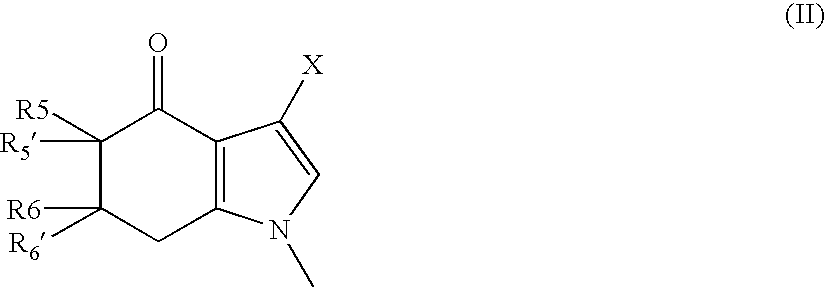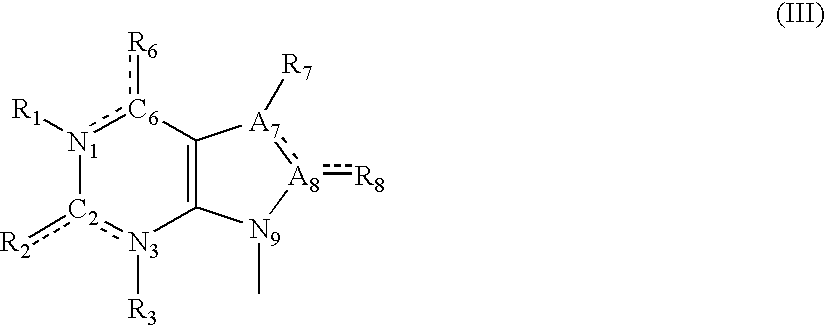Tetrahydroindolone and purine derivatives linked to arylpiperazines
a technology of arylpiperazine and purine derivatives, which is applied in the field of compound compounds, can solve the problems of limited benefit of high-pharmacological selectivity therapies, difficult to effectively treat disorders, and ineffective treatment, so as to enhance the therapeutic properties of arylpiperazine moiety, improve cognition, and improve cognitive function
- Summary
- Abstract
- Description
- Claims
- Application Information
AI Technical Summary
Benefits of technology
Problems solved by technology
Method used
Image
Examples
example 1
Synthesis of 1-{2-[4-(3-Trifluoromethylphenyl)piperazin-1-yl]ethyl}-1,5,6,7-tetrahydroindol-4-one (NEO-359)
This example demonstrates a method of preparing 1-{2-[4-(3-Trifluoromethylphenyl)piperazin-1-yl]ethyl}-1,5,6,7-tetrahydroindol-4-one by a two step procedure. Generally, the arylpiperazine moieties are prepared first, then the arylpiperazine molecules are reacted with tetrahydroindolones.
Step 1: Preparation of 1-(2-Chloroethyl)-4-(3-trifluoromethylphenyl)piperazine
To a 100 mL flask was added 4-(3-trifluoromethylphenyl)piperazine HCl (5035 mg, 18.88 mmol) and 60 mL dichloromethane. 1-Bromo-2-chloroethane (1730 .mu.l, 20.78 mmol, 1.10 eq) was added, then triethylamine (5.25 mL, 37.7 mmol, 2.00 eq). The solution was refluxed for 9 hours, then cooled to 25.degree. C. 100 mL of hexane was then added, and the resulting suspension was vacuum filtered. The filtrate was concentrated in vacuum and purified by column chromatography using dichloromethane as eluant resulting in an oil of 1-(...
example 2
Synthesis of 1-{3-[4-(3-Trifluoromethylphenyl)piperazin-1-yl]propyl}-1,5,6,7-tetrahydroindol-4-one (NEO-356)
Step 1: Preparation of 1-(3-Chloropropyl)-4-(3-trifluoromethylphenyl)piperazine
To a 100 mL flask was added 1-(3-trifluoromethylphenyl)piperazine HCl (5035 mg, 18.88 mmol) and 60 mL dichloromethane. 1-Bromo-3-chloropropane (1730 ul, 20.78 mmol, 1.10 eq) was added, then triethylamine (5.25 mL, 37.7 mmol, 2.00 eq). The solution was refluxed for 9 hours, then cooled to 25.degree. C. 100 mL of hexane was then added, and the resulting suspension was vacuum filtered. The filtrate was concentrated in vacuum and purified by column chromatography using dichloromethane as eluant resulting in an oil of 1-(3-Chloropropyl)-4-(3-trifluoromethylphenyl)piperazine.
Step 2: Preparation of 1-{2-[4-(3-Trifluoromethylphenyl)piperazin-1-yl]propyl}-1,5,6,7-tetrahydroindol-4-one
The compound is synthesized by reacting the 1-(3-Chloropropyl)-4-(3-trifluoromethylphenyl)piperazine with 1,5,6,7-Tetrahydroin...
example 3
Synthesis of 1-{3-[4-(3-Chlorophenyl)piperazine-1-yl]propyl}-1,5,6,7-tetrahydroindol-4-one (NEO-363)
Since 1-(3-Chloropropyl)-4-(3-chlorophenyl)piperazine HCl is commercially available, step one was omitted.
To a solution of 1,5,6,7-Tetrahydroindol-4-one (135 mg, 1.0 mmol) in 5 mL dimethylsulfoxide was added powdered sodium hydroxide (84 mg, 2.1 mmol) and the solution stirred for 15 minutes at 25 C. 1-(3-Chloropropyl)-4-(3-chlorophenyl)piperazine HCl (310 mg, 1.0 mmol) was then added and stirring continued overnight. Upon completion, by TLC, reaction was partitioned between 50 mL each of dichloromethane and water then separated. The water layer was extracted with 50 mL more of dichloromethane and the combined organic layers washed with brine, dried with sodium sulfate, and concentrated in vacuum to dryness. The crude product was purified via flash chromatography eluting with an ethyl acetate and dichloromethane mixture resulting in the title compound as an oil. The oil was dissolved i...
PUM
| Property | Measurement | Unit |
|---|---|---|
| logP | aaaaa | aaaaa |
| pH | aaaaa | aaaaa |
| temperature | aaaaa | aaaaa |
Abstract
Description
Claims
Application Information
 Login to View More
Login to View More - R&D
- Intellectual Property
- Life Sciences
- Materials
- Tech Scout
- Unparalleled Data Quality
- Higher Quality Content
- 60% Fewer Hallucinations
Browse by: Latest US Patents, China's latest patents, Technical Efficacy Thesaurus, Application Domain, Technology Topic, Popular Technical Reports.
© 2025 PatSnap. All rights reserved.Legal|Privacy policy|Modern Slavery Act Transparency Statement|Sitemap|About US| Contact US: help@patsnap.com



